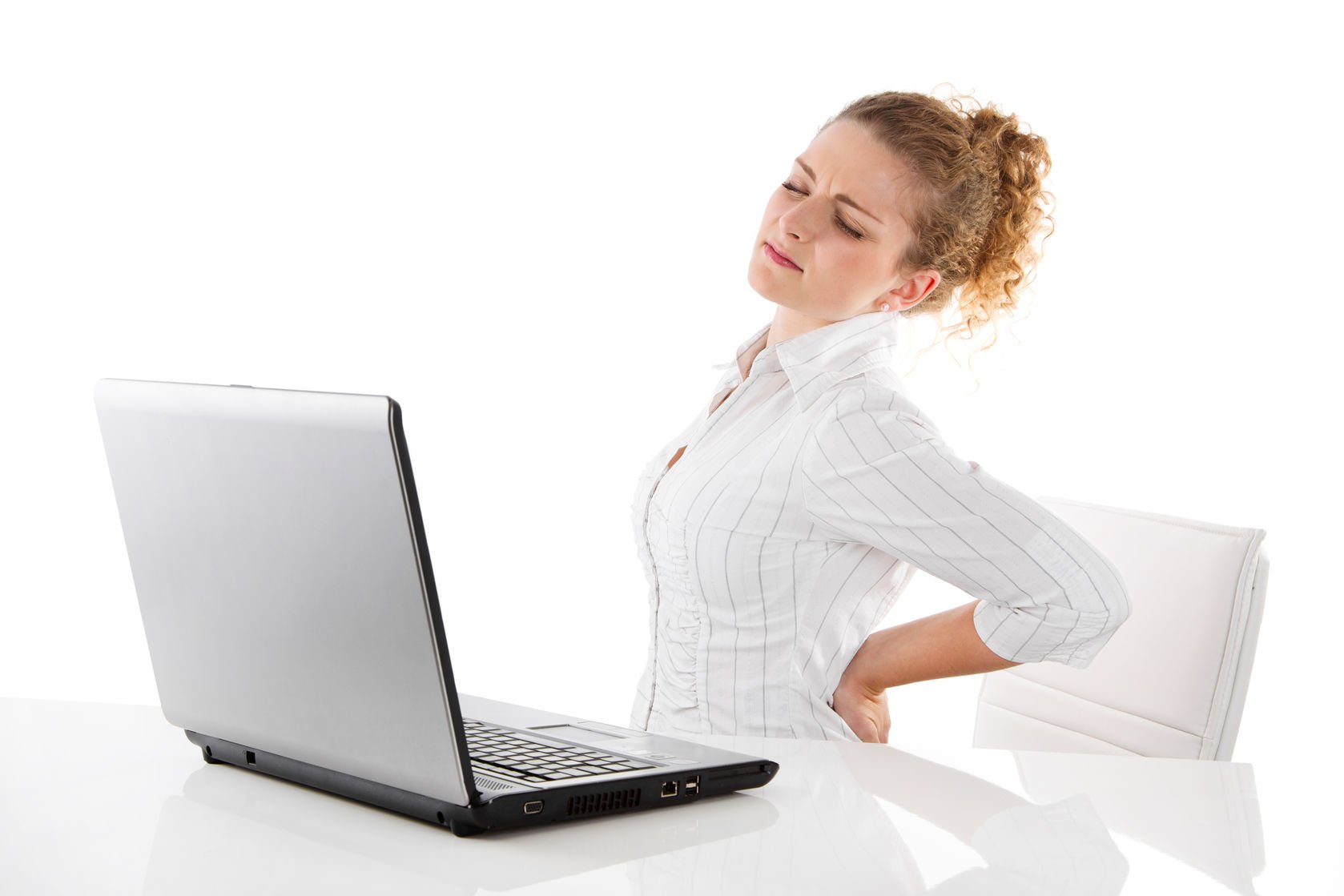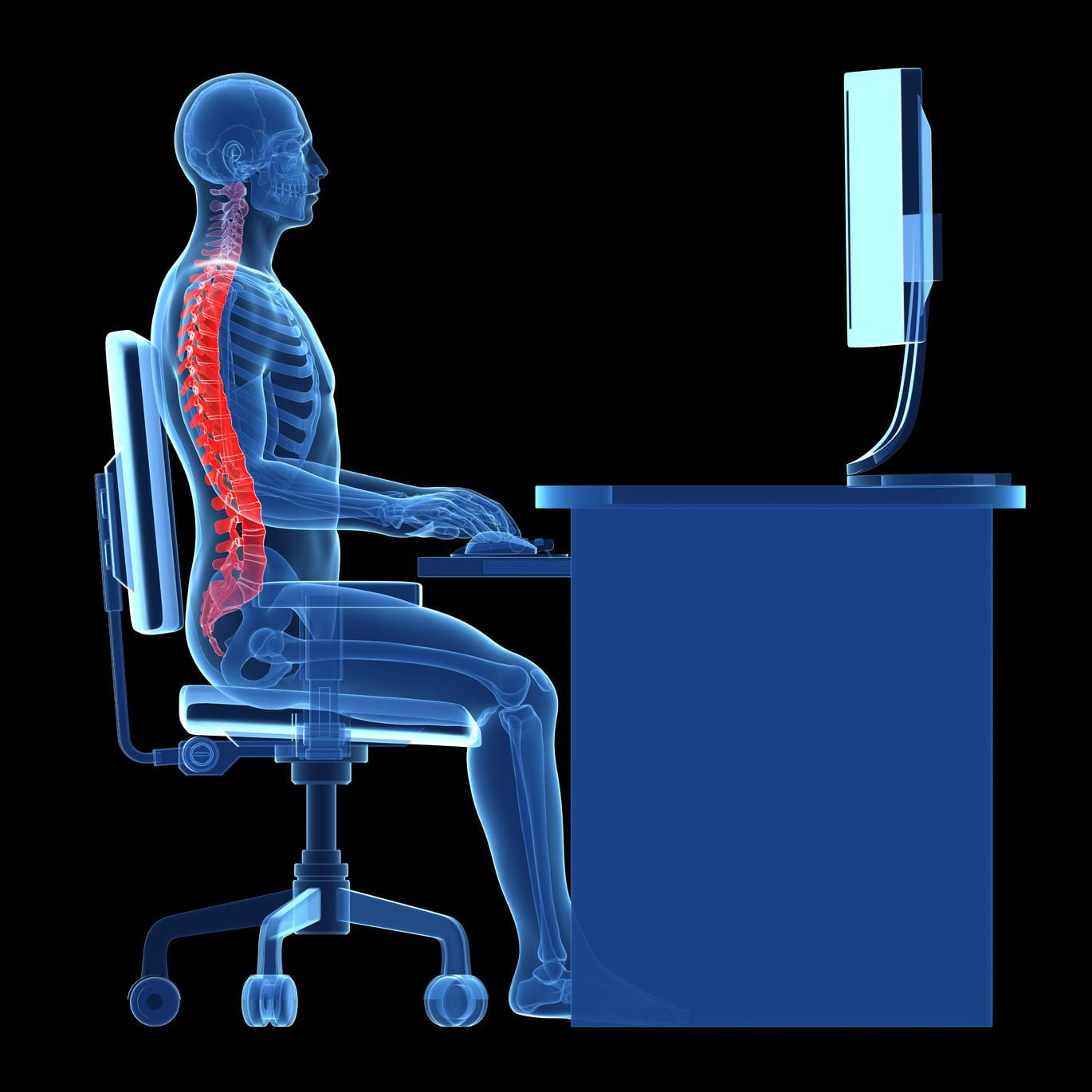Your cart is currently empty!
Category: Ergonomics
Ergonomics and Occupational Health are physiotherapy services of Free2move Physiotherapy North Perth
-

5 Ways to Counteract Sitting at Work

Five Ways to Counteract Sitting at Work
1. Micro-breaks
Eye breaks – every 20 minutes spend 20 seconds focusing your eyes on something 20 feet away from you (the 20 – 20 – 20 exercise). You should also blink the eyes a few times to lubricate them.

Deep breathing with an overhead stretch (sitting or standing). Interlace the fingers. Take a deep breath in as you raise your hands overhead and turn the palms towards the ceiling, looking upwards slightly. Repeat 3 times.
2. Walking breaks
Once every 30 to 60 minutes move away from your desk and walk briskly around the office. These short periods of activity that are simply part of your daily routine are known as ‘incidental exercise’. They are useful for preventing stagnation of the circulation. They help to raise your metabolic rate. There are many apps available to help remind you to get out of your chair.
You may simply get up, walk to another room and drink a glass of water or use the bathroom. It doesn’t necessarily mean that you stop working either. The break could be used, for example, to discuss something with a colleague or use the photocopier. Walking or jogging on the spot can provide an additional boost for your circulation. A short but brisk walk during the lunch break is another possibility.
3. Walking meetings and walking phone calls
Standing or walking during meetings helps increase activity level and lifts metabolic rate. If you use a mobile phone at work, make sure you have earphones with an inbuilt microphone. This way you can remain mobile while talking with colleagues or clients.
4. Walk to work
If you live too far from work to walk there, try parking your car further away and walking for the last 10 or 20 minutes. Taking public transport usually involves walking to and from the train or bus, which could be an improvement on taking your car. Research shows that we need an absolute minimum of 150 minutes a week of cardio-vascular exercise. This can be made up of any blocks of exercise that are at least 10 minutes long.
5. Active computer work stations and fit desks
Active work stations and fitdesks are a fantastic way to increase activity levels during the working day. Treadmill work stations allow you walk while you work. Cubii is an under desk elliptical that you can use while you work, without your knees hitting the desk. It has bluetooth connectivity so you can keep track of how far you have pedaled on your phone. Here is an interesting article that compares cycling desks with treadmill desks. The treadmill desks are more expensive but don’t interfere as much with productivity and the ability to work on a computer.
Stretches you can do at your desk
Stretches at work are helpful for reducing muscular tension and feelings of stiffness.
The following stretches can be done without leaving the vicinity of your desk. They target the most common places people feel tension after being at a computer.
READ OUR DISCLAIMER Please seek medical advice before commencing exercises, if you have a painful or medical condition.

Spine twist – Sitting in your chair, twist around to one side and look behind you, hold for a few seconds and repeat to the other side. This exercise helps stretch the shoulders, lengthen the back and fills the lungs with air, expanding the chest.

Forward bend – Sitting in your chair, slide your arms down your legs and let you head hang forwards, hold for 2 or 3 breaths in and out, then return to sitting. This gently stretches the lower back if it has been arching or compressed. It may help to help relieve lower back tension.

Pectoral stretch – Stand up, interlace the hands behind your back and raise the arms slightly towards the ceiling. The pectoral muscles at the front of the shoulders often become tight while using a keyboard. This exercise helps to lengthen them.

Back bend standing – Stand up, tighten the buttock muscles, use the hands to support the lower back and gently lean backwards, while looking upwards. Repeat several times without holding. This helps to counteracted a rounded lower back that can occur from slouching.

Stop sign stretch – Stretch one arm out in front of you with your elbow straight and your palm facing forwards, as in a policeman’s stop sign. Use the other hand to gently stretch the fingers back. Hold for a few seconds then repeat on the other side. This forearm stretch helps prevent Golfer’s Elbow (pain on the inside of the elbow).

Forearm stretch – Make a soft fist with one hand and extend it out in front of you, elbow straight. Turn the thumb side of the hand slightly towards the floor. Use the other hand to gently bend the wrist downwards. Do not do this stretch if you feel strain in the wrist. You may feel a stretch in the forearm if the extensor muscles which attach to the outside of the elbow are tight. Tight wrist extensors can lead to Tennis Elbow.
Also refer to our article “The Risks of Prolonged Sitting”
-

Improving Posture

Improving Posture
Have you ever tried to improve your posture? How well did that work for you? If you are not satisfied with the results, consider attending Feldenkrais classes. The Feldenkrais Method can help you achieve comfortable and effortless posture through ingenious and mindful movement exercises.
The changes become integrated into your every-day life. Soon you will find yourself sitting, standing and moving in ways that you never imagined could be so easy or comfortable.
Body Scan Exercise in Sitting
Sit on a firm chair with your feet flat on the floor. Come forward in the chair a bit so you are not using the back rest. Sit normally and close your eyes for a few moments. Notice your posture. Stay there for a minute or two just observing yourself. Then open your eyes again.
When you observed your posture, what is the first thing that came into your awareness? What parts of the body did you sense? Perhaps you thought about whether you were sitting or standing up straight? You might have become aware or your head, neck and back. Perhaps you sensed your spine and checked its alignment. Maybe you tried to correct yourself. These are things many of us were taught to do growing up.
Consider that parts of your body that may not have been included in your awareness. Your hands and feet? Your chest and rib cage? Was your abdomen free to move with the breath? How long could you sustain this posture comfortably
3 minutes to Better Posture
Now try this short exercise with Ruthy Alon. Then go back to the sitting body scan above and feel the difference.
About Ruthy Alon
Ruthy is an international Feldenkrais trainer who studied and taught with Moshe Feldenkrais for over 20 years. It is hard to believe that in this video she is 85 years old. Ruthy is still teaching, a huge inspiration for those of us interested in healthy ageing.
4 Reasons why trying harder to sit or stand up straight doesn’t work
1. When we try to straighten the spine we often increase effort in the muscles of the back without releasing the flexor muscles in the front of the body. The result is one muscle group working against another. This causes spinal compression.
2. Some of us work so hard in our back muscles to maintain good posture that we end up bowed backwards, thinking that we are actually straight. This ‘military’ style of posture can lead us to be stiff and stuck in our movements. People who do this are usually unaware of it.
3. A common frustration in trying to improve posture is that the changes only work while you are consciously paying attention. As soon as you stop doing that, you slip back into old habits.
4. Yet another problem with this method is that the effort to straighten can result in restriction of the breathing.
4 Ways that Feldenkrais helps improve posture
1. Focusing on dynamic, not static posture
Moshe Feldenkrais described good posture as ‘the ability to move equally easily in all directions’. This is dynamic posture. By contrast, static posture may involve trying to hold yourself still when you are sitting or standing. This may cause breath holding. It’s also literally impossible be completely still. We actually maintain our balance in upright positions by using subtle swaying movements.
2. Reducing effort
As you learn where to let go of unnecessary effort, you will discover how to find more efficient support from your muscles and bones. Learning to move easily in and out of a particular position is just as important as maintaining good alignment.
3. Learning first while lying down
To learn a new way of supporting the body against gravity Moshe Feldenkrais first taught a variety of movement lessons lying down. The reason is that lying down makes it easier to reduce muscular effort. This helps you sense what you are doing more clearly so you can make small adjustments towards greater efficiency. It means you are less likely to fall into inefficient habitual patterns and postures.
4. Expanding the self-image
In the Feldenkrais Method you will learn to bring your attention to each part of the body that is involved in an action. You will learn how even seemingly unrelated parts of the body such as your hands, feet, eyes, ribs and hip joints can influence your posture. The more parts of your body that can be included in your self-image, the more clearly you will know what you are doing. In the words of Moshe Feldenkrais ‘When you know what you’re doing you can do what you want’.
“When you know what you’re doing you can do what you want” – Moshe Feldenkrais.
-

Ergonomic Computer Work Stations

Ergonomic Computer Work Stations
Ergonomic computer work station set up is relatively simple. Doing things in the correct sequence is the key to getting it right. This helps minimise strain on your joints, muscles and soft tissues while working at your computer and reduces the risk of occupation overuse syndromes.
Adjust your chair first
- Adjust seat height
- Adjust the height of your back rest
- Adjust the back rest angle
- Adjust the seat slope
- Sit to the back of your chair
- Do you need a foot rest?
Adjust your monitor height next
- Adjust monitor height—eyes approximately 5cm below top of screen
- Do you need a monitor raiser?
- Position monitor arms length from your seated position
- If you have 2 monitors, position them to avoid twisting
Keyboard and Mouse
- Normal keyboard and mouse—suitable for most people
- Frequent use of numbers—numeric keypad
- Frequent use of mouse, but not numbers—mini keyboard
- An ergonomic mouse and or gel wrist / mouse support or a negative tilt keyboard may help some people
Laptops
- Avoid prolonged work (more than one hour)
- Use an external keyboard, laptop ramp, or plug your laptop into an external monitor
Other ergonomic considerations
- Your phone should be within close reach
- Wear a headset if you will be typing while on the phone.
- Use a document holder to reduce twisting of your neck.
- Excessive brightness, glare or inadequate light can strain your eyes
- Inadequate ventilation or being too cold or too hot at work can impair your performance.
Home visit and site visit services
Free2Move offer a home or site visit service to provide individual solutions to ergonomic computer work station issues
Please note: The above suggestions are a guide only. If you are experiencing pain or any other difficulties with your workstation, please seek the guidance of a health professional with an understanding of ergonomics.
-

Repetitive Strain Injury

Repetitive Strain Injury
Repetitive Strain Injury (RSI)
Repetitive Strain Injury is also known as Occupational Overuse Syndrome (OOS). These terms cover a group of separate disorders, all of which are related to repetitive trauma to the nervous and musculo-skeletal system.
The trauma can occur because of working for prolonged periods in a poor posture. It may be related to poor ergonomics or inefficient bio mechanics. An example would be over-use of the relatively small muscles of the wrist and forearm when performing heavy or repetitive lifting, while under-using the large stabilising or core muscles of the trunk. Although frequently referring to conditions of the arms, RSI can also occur in the lower limbs or trunk.
How We Can Help
At Free2Move we offer a customised treatment programme using a combination of Physiotherapy, Clinical Pilates and / or Feldenkrais. This process begins with a comprehensive 40 minute individual assessment. We examine the bio mechanics of your movement, looking for possible underlying causes, or factors which may be aggravating your pain. Our aim is to promote independent self-management in the shortest possible time frame.
Many of our clients have computer based work and we frequently treat conditions such as Thoracic Outlet Syndrome, Carpal Tunnel Syndrome, Tendonitis, Tendonosis, De Quervain’s Syndrome, Tennis Elbow (Lateral Epicondylitis), Golfer’s Elbow (Medial Epicondylitis) and Trigger Finger.
We can also visit your workplace to perform ergonomic workstation assessments.

